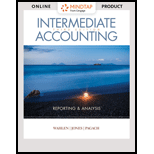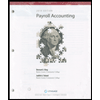
INTERM.ACCT.:REPORTING...-CENGAGENOWV2
3rd Edition
ISBN: 9781337909358
Author: WAHLEN
Publisher: CENGAGE L
expand_more
expand_more
format_list_bulleted
Question
Chapter 19, Problem 16GI
To determine
Explain the five possible alternatives method to determine the pension plan liability and identify the alternative that is required by GAAP.
Expert Solution & Answer
Want to see the full answer?
Check out a sample textbook solution
Students have asked these similar questions
What is the expected return on assets?
Quick answer of this general accounting
Need answer
Chapter 19 Solutions
INTERM.ACCT.:REPORTING...-CENGAGENOWV2
Ch. 19 - Prob. 1GICh. 19 - Prob. 2GICh. 19 - Prob. 3GICh. 19 - Prob. 4GICh. 19 - Prob. 5GICh. 19 - Prob. 6GICh. 19 - Prob. 7GICh. 19 - Prob. 8GICh. 19 - Prob. 9GICh. 19 - Prob. 10GI
Ch. 19 - Prob. 11GICh. 19 - Prob. 12GICh. 19 - Prob. 13GICh. 19 - Prob. 14GICh. 19 - Prob. 15GICh. 19 - Prob. 16GICh. 19 - Prob. 17GICh. 19 - Prob. 18GICh. 19 - Prob. 19GICh. 19 - Prob. 20GICh. 19 - Prob. 21GICh. 19 - Prob. 22GICh. 19 - Prob. 23GICh. 19 - The actuarial present value of all the benefits...Ch. 19 - Prob. 2MCCh. 19 - Prob. 3MCCh. 19 - Prob. 4MCCh. 19 - Prob. 5MCCh. 19 - Prob. 6MCCh. 19 - Which of the following is not a component of...Ch. 19 - Prob. 8MCCh. 19 - Prob. 9MCCh. 19 - Prob. 10MCCh. 19 - Prob. 1RECh. 19 - Prob. 2RECh. 19 - Pinecone Company has plan assets of 500,000 at the...Ch. 19 - Prob. 4RECh. 19 - Prob. 5RECh. 19 - Prob. 6RECh. 19 - Prob. 7RECh. 19 - Prob. 8RECh. 19 - Given the following information for Tyler Companys...Ch. 19 - At the beginning of Year 1, Cactus Company has...Ch. 19 - Prob. 11RECh. 19 - Prob. 1ECh. 19 - Prob. 2ECh. 19 - Prob. 3ECh. 19 - Prob. 4ECh. 19 - Prob. 5ECh. 19 - Prob. 6ECh. 19 - Prob. 7ECh. 19 - Prob. 8ECh. 19 - Prob. 9ECh. 19 - Prob. 10ECh. 19 - Prob. 11ECh. 19 - Prob. 12ECh. 19 - Prob. 13ECh. 19 - Refer to the information provided in E19-13....Ch. 19 - Prob. 15ECh. 19 - Prob. 16ECh. 19 - Prob. 1PCh. 19 - Prob. 2PCh. 19 - Prob. 3PCh. 19 - Prob. 4PCh. 19 - Prob. 5PCh. 19 - Prob. 6PCh. 19 - Prob. 7PCh. 19 - Prob. 8PCh. 19 - Prob. 9PCh. 19 - Prob. 10PCh. 19 - Prob. 11PCh. 19 - Prob. 12PCh. 19 - Prob. 1CCh. 19 - Prob. 2CCh. 19 - Prob. 3CCh. 19 - Prob. 4CCh. 19 - Prob. 5CCh. 19 - Prob. 6CCh. 19 - Prob. 7CCh. 19 - Prob. 9C
Knowledge Booster
Similar questions
- In 2022, Rolling Mills, a producer of organic oat flour, had the capacity to produce 12,000,000 pounds of product at a conversion cost per pound of $0.18. The conversion cost per pound was $0.14 in 2021 (the previous year). The direct material cost per pound for both years was $0.09 per pound. In 2022, Rolling Mills produced 10,500,000 pounds, while actual production for the previous year was 9,200,000 pounds. What was the cost of unused capacity in 2022?arrow_forwardWhat is the smartphone Division's capital turnover?arrow_forwardMCQarrow_forward
arrow_back_ios
SEE MORE QUESTIONS
arrow_forward_ios
Recommended textbooks for you
 Intermediate Accounting: Reporting And AnalysisAccountingISBN:9781337788281Author:James M. Wahlen, Jefferson P. Jones, Donald PagachPublisher:Cengage Learning
Intermediate Accounting: Reporting And AnalysisAccountingISBN:9781337788281Author:James M. Wahlen, Jefferson P. Jones, Donald PagachPublisher:Cengage Learning Principles of Cost AccountingAccountingISBN:9781305087408Author:Edward J. Vanderbeck, Maria R. MitchellPublisher:Cengage Learning
Principles of Cost AccountingAccountingISBN:9781305087408Author:Edward J. Vanderbeck, Maria R. MitchellPublisher:Cengage Learning

Intermediate Accounting: Reporting And Analysis
Accounting
ISBN:9781337788281
Author:James M. Wahlen, Jefferson P. Jones, Donald Pagach
Publisher:Cengage Learning



Principles of Cost Accounting
Accounting
ISBN:9781305087408
Author:Edward J. Vanderbeck, Maria R. Mitchell
Publisher:Cengage Learning
